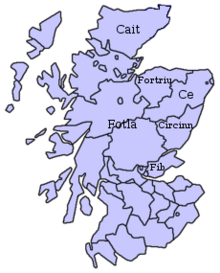
Cait or Cat was a Pictish kingdom originating c. AD 800[1] during the Early Middle Ages. It was centered in what is now Caithness in northern Scotland. It was, according to Pictish legend, founded by Caitt (or Cat), one of the seven sons of the ancestor figure Cruithne. The territory of Cait covered not only modern Caithness, but also southeast Sutherland.[2]
The place name Caithness derives from Cait, which is also preserved in the Gaelic name for Sutherland (Cataibh), in several specific names within that county and in the earliest recorded name for Shetland (Inse Catt, meaning "islands of the Cat people").[3]
Watson (1994) compared this usage with the early Irish Innse Orc (islands of the boars) for Orkney and concluded that these are tribal names based on animals.[3]
History[edit]
See also[edit]
References[edit]
- ^ Chadwick, Hector Munro (1949). Early Scotland: The Picts the Scots & the Welsh of Southern Scotland. Cambridge: Cambridge University Press. p. 81. Retrieved 4 July 2017.
- ^ "The Making of the Kingdom of Fortriu". Rampant Scotland. Retrieved 4 July 2017.
- ^ a b Watson, William J. (1994) [1926]. The Celtic Place-Names of Scotland. Edinburgh: Birlinn. pp. 29–30. ISBN 1-84158-323-5.

Well, that’s interesting to know that Psilotum nudum are known as whisk ferns. Psilotum nudum is the commoner species of the two. While the P. flaccidum is a rare species and is found in the tropical islands. Both the species are usually epiphytic in habit and grow upon tree ferns. These species may also be terrestrial and grow in humus or in the crevices of the rocks.
View the detailed Guide of Psilotum nudum: Detailed Study Of Psilotum Nudum (Whisk Fern), Classification, Anatomy, Reproduction